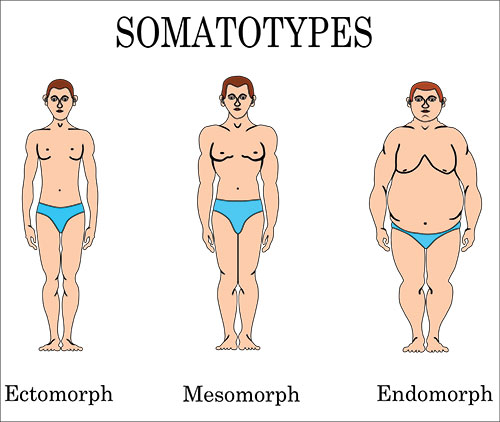
People come in all shapes and sizes. Chances are you already knew that! But what determines a person’s basic body type? Genetics is a factor, although no matter what body type you can improve what you’re born with.
Experts sometimes divide body types into three categories – ectomorph, mesomorph, and endomorph. These are often referred to as “somatotypes.” Of course, this is an oversimplification. Not everyone fits neatly into one of these categories but it’s likely that one body type describes you better than another.
Which body somatotype type are you and how can you maximize your training based on your body type?
The Ectomorphic Somatotype
Ectomorphs are the body type most resistant to weight gain. You can spot them by their thin build and long, lanky limbs. Other characteristics of ectomorphs:
Small bone structure
Narrow shoulders
Often but not always tall
Little natural muscle definition
There are advantages to being an ectomorph. Ectos typically have a fast metabolism and can eat more without gaining weight than their mesomorphic and endomorphic counterparts – but there are drawbacks to being an ectomorph. Ectomorphs have a harder time gaining muscle mass. If you’re an ecto, you have to train harder than other body types to get muscle definition.
Don’t assume because an ectomorph doesn’t gain weight easily that they have a healthy body composition. There’s a growing number of “skinny-fat” ectos out there who have a high body fat percentage despite being at or below their ideal body weight. That’s why all ectomorphs need strength training.
Ectomorph Training Tips
How can you fine-tune your training and nutrition if you’re an ectomorph? Focus a significant portion of your training time on strength exercises. Keep your cardiovascular workouts short and intense with high-intensity interval training and avoid doing long periods of moderate-intensity cardio. Long cardio sessions can make it harder for you to build lean body mass.
For resistance training focus on high-intensity lifting using a weight that fatigues your muscles after 6 to 10 reps. Circuit training workouts using lighter weights and higher reps aren’t the most effective way to get the definition your body type needs.
Focus on good nutrition. You need more calories and protein to build muscle than other body types. Make sure you’re eating three meals a day and two or three protein snacks in between to supply your muscles with the building blocks they need to grow. Without adequate calories and protein, you’ll have a hard time getting defined.
Endomorphic Somatotype
Unlike the ectomorph, endomorphs gain weight easily. An endomorph’s body is naturally round and soft. Any muscle definition is usually covered by a layer of fat. Although endomorphs have problems shedding body fat they have an easier time gaining muscle than ectomorphs do. Their main frustration is losing body fat. Other endomorphic characteristics:
Slow metabolism
Often but not always short in stature
Rounded body with little muscle definition
Relatively thick arms and legs
Endomorphic Training Tips
If you’re an endomorph, ramp up your cardio sessions. An ectomorph might do well with only two cardio sessions a week, but your goal is to burn body fat while preserving lean body mass Aim for three or four cardio sessions a week and vary the type you do. For example, you might do spin or step workouts two days a week and at least one high-intensity session a week.
Strength training is important because more muscle will boost your metabolic rate but you’ll also benefit from circuit workouts using lighter weights. The key is to move quickly from exercise to exercise so you’ll burn more calories and fat while conditioning your body. Once you’ve lost some body fat, increase the number of strength training workouts you do to build lean body mass and increase your resting metabolic rate.
In terms of nutrition, watch the carbs. Choose carbohydrates that are rich in fiber from whole foods and eliminate processed carbs and added sugar from your diet. Replace potatoes, rice, and pasta with non-starchy vegetables. Starchy carbs create a hormonal environment that makes it harder to lose body fat.
Mesomorphic Somatotype
Mesomorphs are naturally endowed with muscle definition and their muscles respond quickly to resistance training. Of the three body types, mesomorphs put on muscle the easiest. Though you see this body type more often in men, women can also be mesomorphic. Other characteristics of mesomorphs:
Natural muscle definition
Often have natural athletic ability
Rectangular body shape
Naturally strong
Mesomorphic Training Tips
Mesomorphs are lucky because they have natural muscle definition and build lean body mass easily. The downside? Some mesomorphs also have a tendency to put on body fat. If you’re a mesomorph, a balanced workout will help you retain or modestly enhance the muscle you have and avoid gaining body fat.
Circuit and Bootcamp workouts with lots of variety help burn fat without greatly increasing muscle size. If your goal isn’t to increase muscle mass, use lighter weights and higher reps during some of your resistance training but don’t neglect strength training either. You still lose lean body mass with age even if you’re a mesomorph.
In terms of diet, aim for a balanced whole food diet. A good ratio is 30% protein, 40% healthy carbohydrates and 30% healthy fat.
The Bottom Line?
You may not fall completely into one of these categories. One part of your body might be ecto while another is endomorphic or mesomorphic. For example, you might have thin arms, lanky arms (ecto) but muscular in your lower body (meso). In this case, focus on high-intensity strength training with fewer reps for the upper body and higher reps and more cardio for your lower body. It’s not an exact science, but knowing your body type or somatotype can help you optimize your training and nutrition and maximize your results.
References:
University of Houston. “The Three Somatotypes”
Related Articles By Cathe:
Goodbye BMI: is There a New Way to Measure Obesity?

